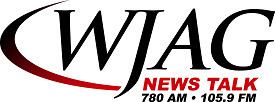Translator(s) 105.9 FM (K290AT) Facility ID 73121 City of license Norfolk Owner WJAG, Inc_ | First air date September 13, 1922 Class D Frequency 780 kHz | |
 | ||
Branding Newstalk WJAG 780 AM and 105.9 FM Affiliations Fox News Radio, Premiere Networks, Westwood One | ||
Wjag 1
WJAG (780 AM, "Newstalk 780") is a radio station broadcasting a News Talk Information format. Licensed to Norfolk, Nebraska, United States, since 1922 the station was initially licensed to the Huse Publishing Company, publisher of the Norfolk Daily News, and later (1956) to a subsidiary, WJAG, Inc.
Contents
Wjag morning show intro
Programming
WJAG features news and talk radio programming from ABC Radio, Premiere Radio Networks and Westwood One. WJAG operates during daylight hours only, in order to protect the nighttime signal of WBBM (780 AM) in Chicago.
In July 2008, WJAG became one of a handful of AM stations to operate a co-located FM translator. K290AT at 105.9FM carries WJAG's programming 24 hours a day, including overnight hours after the AM closes down. The nationally syndicated CBS Sports Radio Network fills much of the overnight airtime.
WJAG is the sister station to Norfolk's KEXL-FM.
History
WJAG was licensed on July 27, 1922, but didn't officially go on the air until September. At 12:15 p.m. on September 13, 1922, WJAG broadcast its first program: a news and farm market report. The station's initial power was 100 watts, and its first broadcasts consisted of three afternoon news and market reports: at 12:15, 3:30 and 5:30. The three reports were termed a "temporary schedule until enough (listener) cards come in indicating changes should be made."
WJAG was founded by the publisher of the Norfolk Daily News. The station's original slogan was "The Voice of the Norfolk Daily News." The newspaper's city editor in 1922, Karl Stefan, anchored the station's first news report and served as chief announcer until his election to Congress in 1935.
WJAG's first studio consisted of a single room in the building that housed the newspaper. Early programming consisted of performances by community choral groups, barbershop quartets and polka bands. The station's first remote broadcast was prompted by a performance by a 67-member choir. The choir was too large to fit in the one-room studio, and the station was able to obtain use of the automobile showroom at the neighboring Buick dealer. A wire was run across the street to carry audio of the choir's performance from the dealership to the studio.
The original, make-shift studio was originally constructed in the Norfolk Daily News building at the corner of 4th Street and Braasch Avenue in downtown Norfolk. It was then moved to the Hotel Norfolk, at 108 N. Fourth St. in Norfolk, from 1926 to 1945, but within ten years the studio was moved twice to alternate locations in downtown Norfolk. As Mark Smith explains in his extensive history of WJAG:
"At the close of WWII, WJAG moved its business office and main control facilities to a remodeled building, formerly occupied by an insurance company, at Sixth Street and Norfolk Avenue. The hotel broadcast facility, the site of WJAG programming since the late 1920s, was limited to a single control room-studio. The new location consisted of a main control room and two studios. From its inception in 1922, WJAG used the Norfolk Daily News Associated Press (AP) newspaper wire to supply listeners with state and national news. In May 1945 an AP radio wire, which distributed edited versions of news stories written in broadcast style, was installed in WJAG’s new facility on Norfolk Avenue. In 1955, the WJAG studios moved to a new facility at 309 Braasch Avenue, adjacent to the site of its original broadcasts from the News building in 1922. The modern studios, specifically designed for broadcasting with 4,900 square feet of space, incorporated a control room, two studios, a separate newsroom, and enlarged business office. A “sound lock,” a hallway adjacent to the studios with sound-proof doors, dampened outside noise, and the largest studio –– “studio A” –– accommodated large performances and audiences. A WJAG “open house” in December 1955 attracted nearly five thousand visitors. With its latest move the station had entered the modern era of broadcasting."
The station did not begin to sell commercial spots until after its fifth year of operation.
